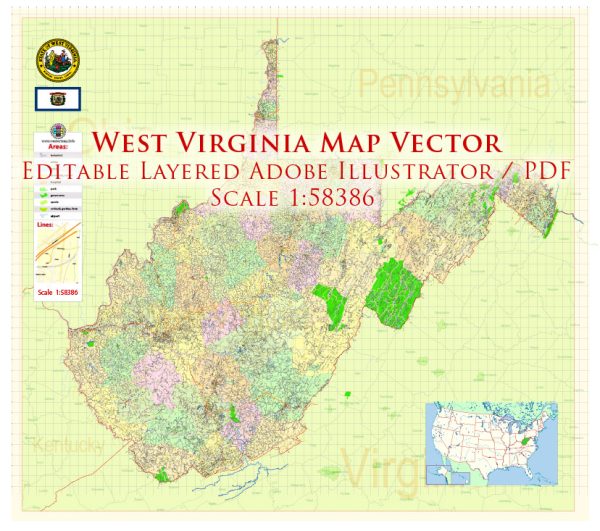West Virginia, located in the Appalachian region of the United States, has a history of urban development shaped by its geography, natural resources, and economic activities. Here’s an overview of key phases in the history of urban development in West Virginia:
Early Settlement and Industry:
- Colonial and Early Settlement:
- The region that is now West Virginia was initially part of Virginia until the Civil War. Early settlement by European colonists, predominantly of German and Scotch-Irish descent, began in the 18th century.
- Agriculture and Mining:
- The early economy revolved around subsistence farming. However, the discovery of coal and the development of mining operations in the 19th century played a crucial role in shaping the state’s urban landscape.
19th Century Boom and Industrialization:
- Coal and Timber Industries:
- The late 19th and early 20th centuries marked a significant boom in the coal and timber industries. Mining towns and company-owned communities sprang up to support these extractive industries.
- Railroads:
- The expansion of railroads was essential for transporting coal and timber from the interior to markets. This infrastructure development influenced the growth of towns along railroad lines.
- Company Towns:
- Many urban centers in West Virginia were established as company towns, where mining or industrial companies owned and operated entire communities, including housing, stores, and schools.
20th Century Economic Shifts:
- Labor Movement and Conflict:
- The coalfields of West Virginia were often the site of labor conflicts, including the famous West Virginia Mine Wars in the early 20th century. Labor movements sought better working conditions and wages.
- Decline of Traditional Industries:
- In the latter half of the 20th century, the decline of traditional industries like coal and timber led to economic challenges and population decline in certain areas. Many small towns faced economic hardship.
Contemporary Urban Development:
- Economic Diversification:
- In recent decades, West Virginia has sought to diversify its economy beyond traditional industries. Efforts have been made to attract technology, healthcare, and tourism-related businesses.
- Education and Healthcare:
- The state’s capital, Charleston, has seen growth in education and healthcare sectors. Institutions like West Virginia University contribute to the development of Morgantown as an educational and research hub.
- Tourism and Outdoor Recreation:
- The state’s natural beauty, including the Appalachian Mountains, has led to a focus on tourism and outdoor recreation. Towns such as Harpers Ferry, known for its historical significance, attract visitors.
- Urban Redevelopment:
- Some urban areas have undergone revitalization efforts, with a focus on preserving historic architecture and creating vibrant downtown spaces. Wheeling, for example, has seen initiatives to revitalize its historic district.
- Infrastructure and Connectivity:
- Investments in infrastructure, including highways and broadband, aim to improve connectivity and support economic development throughout the state.
- Challenges and Opportunities:
- West Virginia faces challenges such as population decline, but there are also opportunities for sustainable development. Balancing economic diversification with environmental conservation is a key consideration.
West Virginia’s urban development has been deeply intertwined with its extractive industries, labor history, and economic shifts. As the state adapts to changing economic realities, there is a growing emphasis on diversification, tourism, and creating resilient, sustainable communities.


 Author: Kirill Shrayber, Ph.D.
Author: Kirill Shrayber, Ph.D.